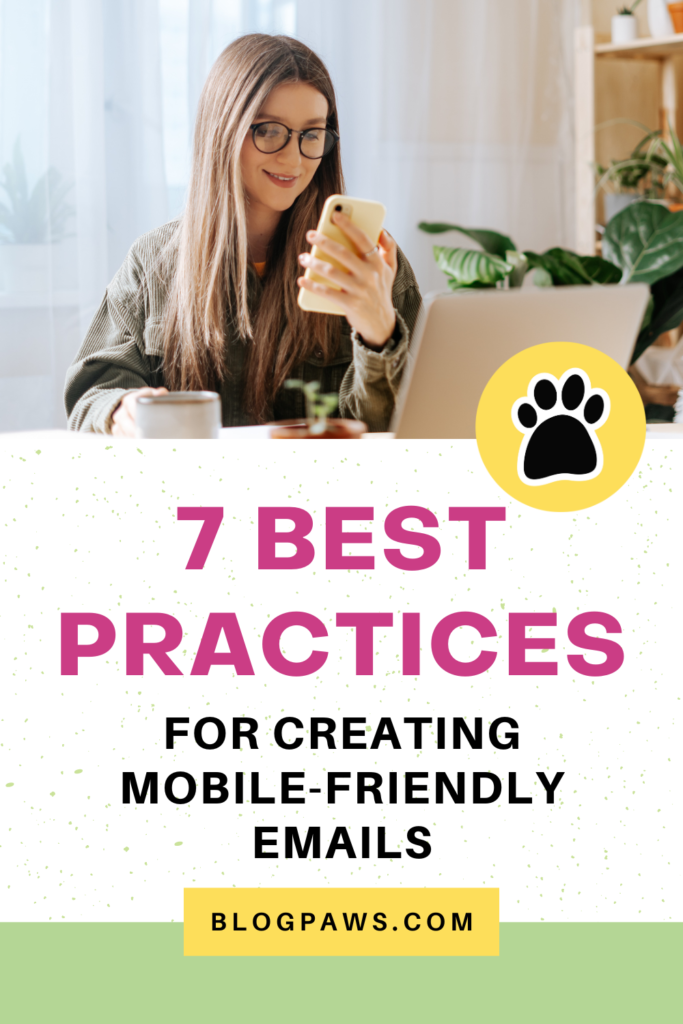7 Best Practices for Creating Mobile-Friendly Emails
As a small business owner, you want to create email content that drives maximum engagement and increases sales. To achieve this, you must ensure that your emails effectively deliver your message to your audience – including those on mobile devices! If you have been paying attention to the top marketing professionals and coaches, you have likely heard them mention mobile-friendly emails. But what does that mean, and how can you harness the power of mobile optimization to drive your business growth?
In this post, we’re going to dig into the basics of mobile optimization in your email marketing efforts, including sharing seven actionable best practices to help you get started. Let’s go…
What is a Mobile-Friendly Email?
Before we dig into the “how-to” of email mobile optimization, we’ll start with the basics. What is a mobile-friendly email anyway?
As the name suggests, a mobile-friendly email is an email that is designed to display properly when it is viewed using a mobile device. While your email will be shown on mobile even if it hasn’t been optimized, the content may simply show as compressed or rearranged to fit. This can take away from the aesthetic appeal and your overall email design.
Creating a mobile-optimized email means intentionally choosing design elements that will translate to the mobile screen correctly.
Why Are Mobile-Friendly Emails Important?
Now that you understand what we mean by mobile-friendly emails, let’s look at why you should prioritize this in your business. It should come as no surprise that mobile browsing is on the rise. In fact, it’s estimated that over 90% of internet users are connecting and browsing using their phones. While this statistic isn’t unique to email marketing, it is eye-opening!
As the use of mobile continues to grow, we can expect that the portion of our audience viewing our emails on mobile will continue to rise.
Here are a few email-specific statistics to consider:
- Approximately 41% of all email views come from mobile devices (HubSpot Blog Research)
- Mobile campaigns that use a mobile-responsive design see a 15% increase in unique mobile clicks (Mailchimp)
- Up to 80% of people viewing an email on their phone will delete it if it isn’t optimized for mobile viewing (Chamaileon)
It’s safe to assume that a large portion of your audience views your email on mobile, even if it isn’t the majority. By designing emails for mobile, you ensure everyone can leverage the valuable information that you are sharing regardless of the device they are using.
How Do I Make My Email Mobile-Friendly?
Okay, so mobile-friendly emails are essential. Great! Now how can you take that knowledge and use it to build your small pet business?
Here are seven mobile email best practices for you to consider when creating your next email campaign. These are simple, actionable items that you can apply to your email marketing to improve your email performance and connect better with your audience today!
Shorten Your Subject Line
Like everything else, the subject line on mobile email is limited. This means that your audience may only be viewing the first portion. Your subject line has a specific purpose in email marketing – encouraging people to open the email. However, if they only see a portion of what you have written there, it may not be effective.
While most desktop email programs will display 60 characters, mobile devices generally limit this to 35-30 characters.
Does this mean you can only write 25-30 characters? Not necessarily. Mobile users know this space is limited and expect to see it cut off. But you want to ensure that the first portion of the subject line includes enough to grab their attention and entice them to want to read more. For example, rather than starting with “You should try these x tips,” consider getting right to the point with “X amazing tips to…”
Increase Your Text Size
Text size has been discussed at length recently in relation to mobile optimization on websites. Small font sizes on desktop can appear tiny and incredibly hard to read on a mobile screen. Rather than zooming in to try to view the content, most users will simply close out and walk away.
The ideal minimum font size for any mobile-friendly content is 16 pixels. However, many experts recommend increasing this slightly for an even better user experience.
BUT avoid increasing your font too far. If your font is overly large, it will significantly limit how much can be shown on the screen at once. This can be frustrating for mobile viewers and have the opposite effect – discouraging them and increasing the number of people who leave without reading your content.
Stick to Short Paragraphs
With the limited screen size, large paragraphs display as a wall of text on smaller screens, like mobile. Many users find this overwhelming, discouraging them from reading the content that you are sending them. Instead, limit your paragraphs to 1-3 sentences in length. This will break your text up into smaller, more manageable pieces.
Be Intentional with Images
Images on a mobile device must fit onto a much smaller screen than they would on a desktop. Depending on how the user views your email, this may be addressed in one of two ways. Either the email will be sized down to fit, or they will only be shown a portion of the image that fits the screen, requiring them to actively pan the screen to see the remainder.
Two key considerations when including images in your email marketing are image size and placement.
To avoid images that are too large to display correctly, it is recommended that you use images with a width from 400 to 650 pixels. This ensures the sizing is large enough to meet the recommended minimum for desktop viewing while addressing the potential challenges mobile users face.
Keep your content to a single column, even with the inclusion of images. This means including any images inline with the text versus having the text wrap around the image to the left or right.
Consider an “Images Off” Experience
To limit the amount of data being used on mobile, many mobile email applications will not display images to the user by default. Instead, your email will open without images and offer the opportunity to download images if they wish. This means a portion of your audience will be viewing your emails without ever seeing the images you are including.
Steer clear of sending image-heavy emails. If you do include an image, don’t make it a necessary component. Instead, ensure that your email delivers your message with or without it, using the image as a bonus for those that see it.
For example, if you are sharing a big sale, an image can be a great visual element to capture the reader’s attention and encourage them to purchase your product. But knowing not everyone will see the image, include all details you are trying to relay in the surrounding text.
Leverage White Space
Don’t shy away from including page breaks between elements of your email. These breaks, known as “white space,” help to break up the email making it less overwhelming to your audience. You can also use this strategically by including a little extra space before and after an important element of the email that you want to draw attention to, like a bolded sentence or a clickable button.
Avoid Small Clickable Elements
If you’re sending your email to get your audience to click through to outside content, like a blog post or sales page, you want to make this as easy as possible for them. Ensure your clickable elements are large enough to easily click on a small mobile screen without accidentally clicking on something else in the email. If possible, include white space before and after.
For emails that will include more than one clickable element, avoid placing them too close together. This could cause the user to accidentally click the wrong email, creating frustration and potentially costing you sales.
What best practices are you currently incorporating into your email marketing? Are there opportunities for you to further prioritize mobile-friendly emails in your small pet business? We would love to hear your thoughts in the comments!
About the Author: Britt Kascjak, BlogPaws Director of Content & SEO, is an award-winning freelance writer whose background in digital and social media marketing spans 15+ years. She’s been a content creator in the pet industry for 9+ years with her own blogs: Shed Happens, The Kas Pack, and Lucifer the Rescue Pup where she shares her life and outdoor adventures with her 2 dogs and 3 cats. Read more…








